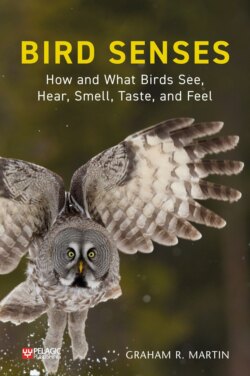Читать книгу Bird Senses - Graham R. Martin - Страница 15
На сайте Литреса книга снята с продажи.
Minimal information
ОглавлениеSensory ecology also suggests that birds are often acting at the limits of their sensory information, responding to what might be considered minimal information, well below the detail that their senses are capable of providing. This use of minimal information should not, however, be too much of a surprise. It is something that we humans often do. However, it is something that we are rarely aware of. There are many occasions when we are prepared to act, sometimes dangerously, although we are not gaining information from within the zone in which our senses perform well and reliably. There is good evidence that birds do the same thing.
We can readily observe human performance at the limits of sensory information when we watch sports. Strength and speed may be obvious in excellent sporting performance, but usually sports people are also working at the limits of their sensory information. Catching or hitting a ball is often achieved at the very limits of what the sense of vision can provide. Gymnasts will go through their routines guided by minimal touch cues; track cyclists are often responding to minimal visual information about the manoeuvres of their competitors.
A more everyday example of humans working at the limits of information occurs when we choose to travel fast. Travelling faster than running speed is very new in our evolutionary history, and often it seems that our senses cannot match the modern challenge of speed. Driving a vehicle at speed (often 10 times faster than an average runner and 20 times faster than a walker) exemplifies an important principle of moving safely at or beyond the limits of sensory information; it can be achieved, but only in relatively simple and predictable situations.
When driving, it is sobering to reflect on the informational challenges that we face. We are very often travelling at speeds well beyond the information that we have immediately available, but we drive as though we have that information. But we can also reflect on how societies have arranged things to allow us to drive safely at speed. The answer is that roads, and the behaviours of other drivers, are engineered and constrained to be highly predictable. This is achieved through high uniformity in the standards of road engineering and in the paraphernalia with which we mark and sign roads.
Humans have developed ways to cope with these challenges of working at the limits of information through engineering solutions. However, through the construction of our artefacts we have also presented birds with many sensory challenges that go far beyond those that their senses evolved to cope with. Hence, we find that many species of birds are prone to collisions with apparently large and obvious human structures, including buildings, wind turbines, power lines, and fences. Other bird species may be faced with novel inedible ‘food items’ with the result that items made of plastics may be ingested, with disastrous outcomes for individuals and populations, especially of seabirds (Figure 1.3).
FIGURE 1.3 Plastic rubbish and power lines both pose serious problems to birds of many species. Large numbers are killed annually due to collisions with power lines and other artefacts, such as wind turbines, fences and netting. Other birds die as a result of ingesting plastic items, sometimes in large numbers. There is growing evidence that these are hazards for birds because they present sensory challenges that are beyond the limits of the information that they have evolved to extract from their environments. (Photograph of plastic pollution on Accra beach, Ghana, by Muntaka Chasant [CC BY-SA 4.0]; photograph of power lines crossing the Karoo, South Africa, by Jessica Shaw.)
These are examples of birds being faced with informational challenges that go well beyond those that they evolved to cope with. But birds also perform actions that are guided by partial information at the limit of what they can detect. This is seen most obviously in species that are active at low light levels, whether it is in a forest at night, within a cave, or in deep or turbid waters (Figure 1.4). As with the case of human car driving, it seems that these behaviours are possible because they occur in highly predictable situations. This predictability can be due to the spatial simplicity of a habitat, but it can also occur in spatially complex habitats which are rendered predictable through a high degree of knowledge gained through territoriality and long residence.
FIGURE 1.4 Great Grey Owl Strix nebulosa and Great Cormorant Phalacrocorax carbo: two species that exploit the resources of challenging environments in which sensory information can often be severely restricted. It seems clear that both species frequently carry out tasks beyond the limits of their immediate sensory information. (Photo of Owl by Danny Green, Cormorant by the author.)
